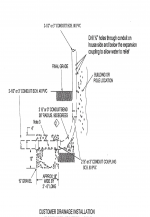Billyohms!
Member
- Location
- Alaska
- Occupation
- Journeyman Electrician
Most airport runways here in Alaska have edge ,taxi, and threshold lights. These are powered by a regulator that maintains a stepped amperage for uniform brightness throughout the runway on a series circuit.
The lights are powered by a # 8 awg 5kv conductor buried 24" in a 2" PVC conduit.
The problem is these conduits inherently accumulate water, freeze and the expanding ice breaks the conductor.
The regulator shuts down when it can't supply enough voltage to maintain amperage.
How can I locate the break?
The lights are powered by a # 8 awg 5kv conductor buried 24" in a 2" PVC conduit.
The problem is these conduits inherently accumulate water, freeze and the expanding ice breaks the conductor.
The regulator shuts down when it can't supply enough voltage to maintain amperage.
How can I locate the break?



